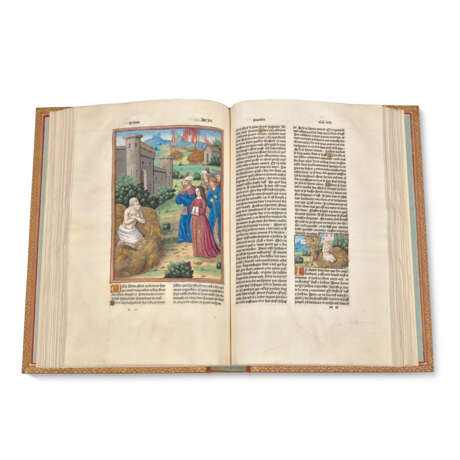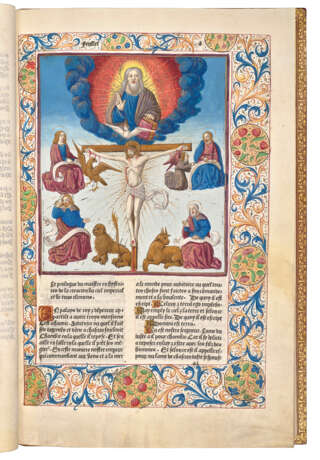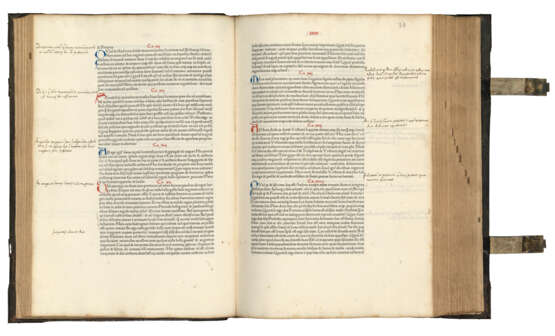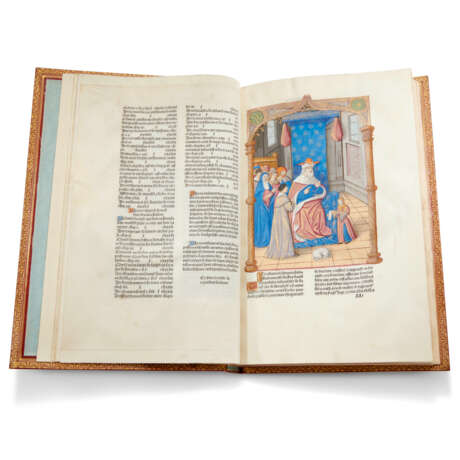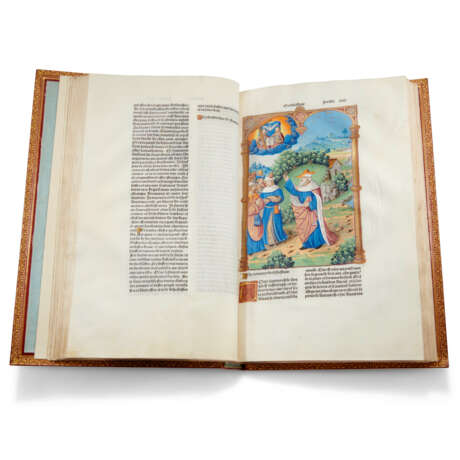ID 794396
Los 83 | BIBLE, in French: La bible historiée
Schätzwert
£ 600 000 – 900 000
Edited by Jean de Rély (c.1430-1499). Paris: Antoine Vérard, [between 8 May 1498 and 25 October 1499].
First edition of a complete French version of the Bible; a deluxe copy, printed on vellum, extensively decorated and illuminated by a contemporary Parisian artist, and with a bibliophile provenance.
The Bible historiée began as an adaptation and translation into French by Guyart des Moulins in the 13th century of Petrus Comestor's 12th-century Historia scholastica. Moulins started the process of replacing parts of Comestor's text with scriptural passages; this was continued through the 14th and 15th centuries until the Bible historiée became a full French version of the Bible. It is here edited by Jean de Rély, confessor to Charles VIII, to whom this first edition is dedicated. All early printed editions of the Bible in French are recensions of this text.
In his dedication to Charles VIII, Rély states that he prepared the text at the king's command. Charles VIII was one of Vérard's greatest patrons, and Vérard regularly presented the monarch with deluxe copies of his publications, printed on vellum and specially illuminated. Charles died in April 1498, however, before printing of the Bible historiée was completed. In addition to the French monarch, Vérard often supplied deluxe vellum copies of his books to a few select patrons and clients, including Henry VII of England, Anne de Bretagne, Jean d'Albret, Louise de Savoie, and George d'Amboise. Curiously, none of the vellum copies of the Bible historiée has any evidence of contemporary ownership, although clearly intended for a special recipient.
The MacCarthy-Reagh-Botfield-Longleat copy is the most complete of four known copies on vellum, and it is the only one remaining in private ownership. The three institutional copies are: New York, Pierpont Morgan Library (imperfect and with miniatures in varying states of completion, the La Vallière-second MacCarthy copy); Lyon, Bibliothèque municipale (imperfect, extensively decorated); and Paris, Bibliothèque nationale (2 sheets replaced in contemporary manuscript, 384 miniatures). Cf. S. de Ricci, 'La "Bible Historiée" d'Antoine Verard', Byblis 2 (1923), pp.15-16: 'd'une extrême rareté'; and Mary Beth Winn, Anthoine Vérard, Parisian Publisher, 1485-1512 (Geneva: 1997), pp.120-122. HC 3145=5539; CIBN B-448; GW 4310; Goff B-623; Pell 2365=3884; Polain(B) 3095; Macfarlane 105; Van Praet, Bib. du Roi I, 44-46 and V, p.362; Chambers, Bib. French Bibles, 13; D & M 3703.
Decoration:
409 miniatures, including 31 large scenes opening major books, 378 column-width scenes, one (uncoloured) diagram, and 2 Vérard devices, all painted by contemporary Parisian artists, the large miniatures opening the first four Biblical books within full painted floral border, the miniatures in volume I painted over, but not wholly dependent on, a printed base, the printed base either not present or printed and erased from volume II (see woodcut on LLL4r, printed and erased, which remains uncoloured, presumably through oversight), printed lombard initials and paragraph marks painted over in liquid gold on alternating magenta or pink ground, the grounds in the Psalter and in supplied leaf II: p6 alternating magenta and blue, yellow capital strokes, pages ruled in red. Calligraphic titles in imitation of Vérard's originals within illuminated historiated border added to vols. II-IV for MacCarthy-Reagh, and by Thomas Willement for Botfield. The woodcuts illustrating this edition derive from Vérard's books of chivalry, his Horae, a new set, and 'an extensive set of small German cuts, evidently made for an edition of the Bible, and closely adapted to the text' (Macfarlane).
2 volumes bound in 4, royal folio (400 x 269mm). Printed on vellum. Volume I: 402 leaves (of 404, without blanks uu10 and [us]6 The division into two volumes occurs after Judges (ending x1). Volume II: 343 leaves (of 344, lacking title to volume II, p6 (last leaf of table to volume II) supplied from MacCarthy's second copy (his sale Paris, 1815, lot 136) and extended at 3 sides). The division into two volumes occurs after Malachi (ending XX10).
Binding: Bound for Botfield by Charles Lewis c.1830, red morocco over thick pasteboard, wide dentelle border on sides, spine decorated in compartments with same tools, two brown leather labels, gilt turn-ins, watered pale blue silk liners, pair of vellum flyleaves, edges gauffered and gilt.
Provenance: Comte Justin MacCarthy-Reagh, who divided the two vols. in 4, supplied the last leaf of the table in vol. II from his second copy (lot 136 in his sale) and added 2 MS frontispieces, which remained unfinished in 1815 (sale Paris, 1815, lot 135, 1300 francs) – George Hibbert (sale 16 March 1829, lot 1228, £54.12 to Payne and Foss) – Beriah Botfield, bought from Payne & Foss for £75 (P.& F. Acquisitions, p. 8, recording £25 to Lewis for rebinding and £6.6 for one new [II:II] and one 'completed' title [II:I] illuminated by Willement; bequeathed to:) – Marquesses of Bath, Longleat (sale Christie’s, 13 June 2002, lot 12).
Special Notice
No VAT on hammer price or buyer's premium.
| Herkunftsort: | Westeuropa, Frankreich, Europa |
|---|---|
| Kategorie des Auktionshauses: | Antiquarische Bücher, Gedruckte Bücher |
| Herkunftsort: | Westeuropa, Frankreich, Europa |
|---|---|
| Kategorie des Auktionshauses: | Antiquarische Bücher, Gedruckte Bücher |
| Adresse der Versteigerung |
CHRISTIE'S 8 King Street, St. James's SW1Y 6QT London Vereinigtes Königreich | |
|---|---|---|
| Vorschau |
| |
| Telefon | +44 (0)20 7839 9060 | |
| Aufgeld | see on Website | |
| Nutzungsbedingungen | Nutzungsbedingungen |
